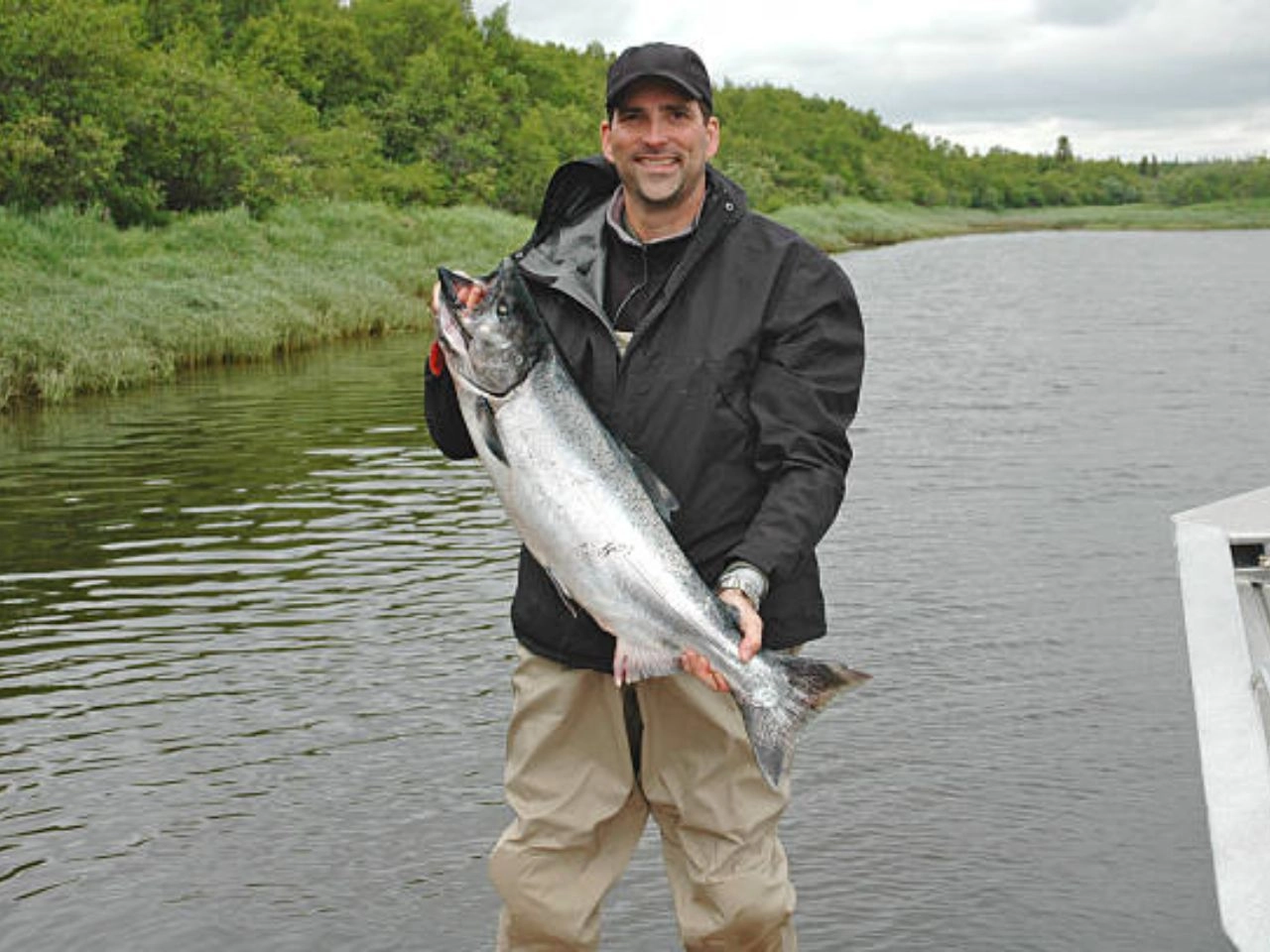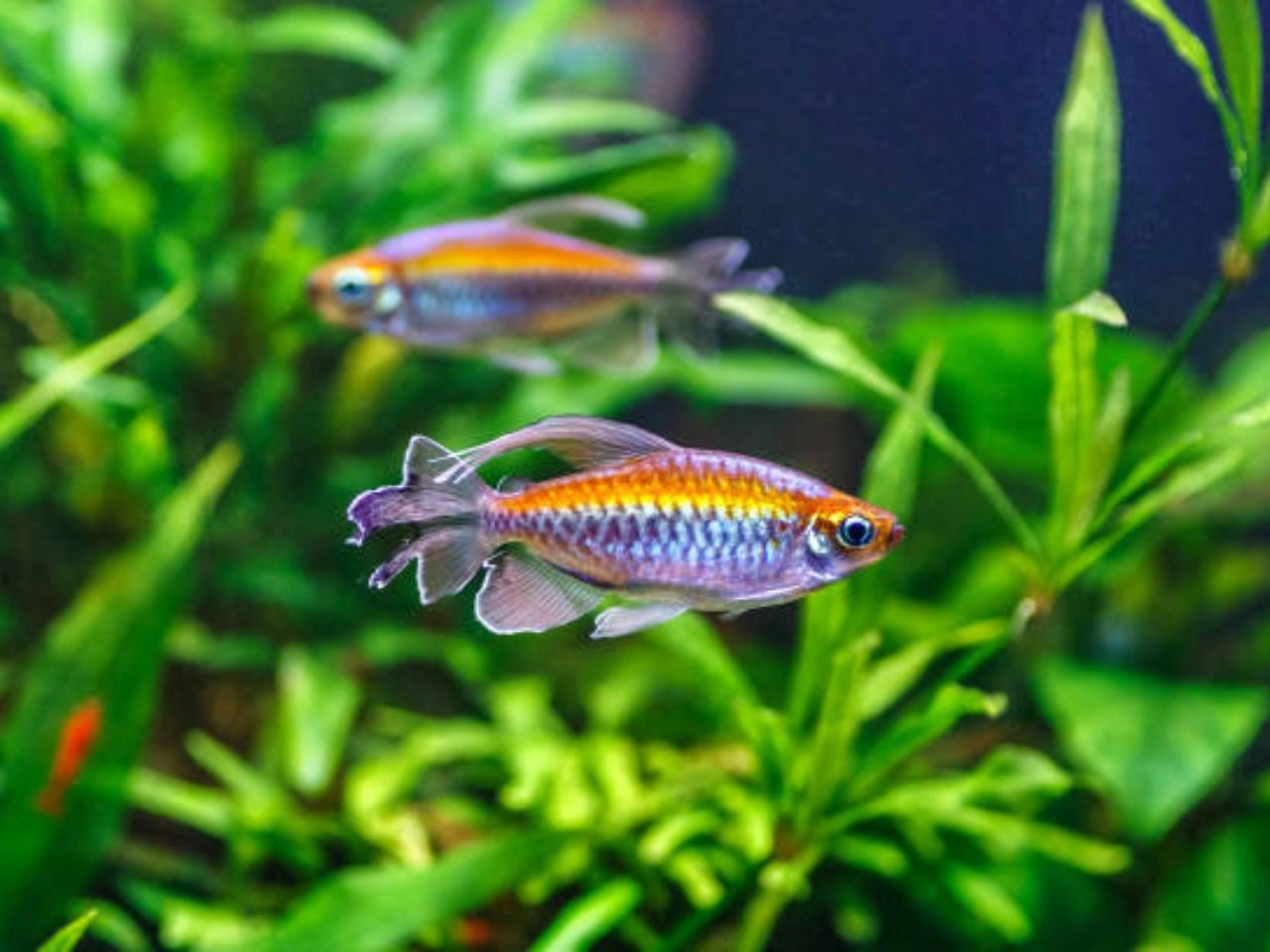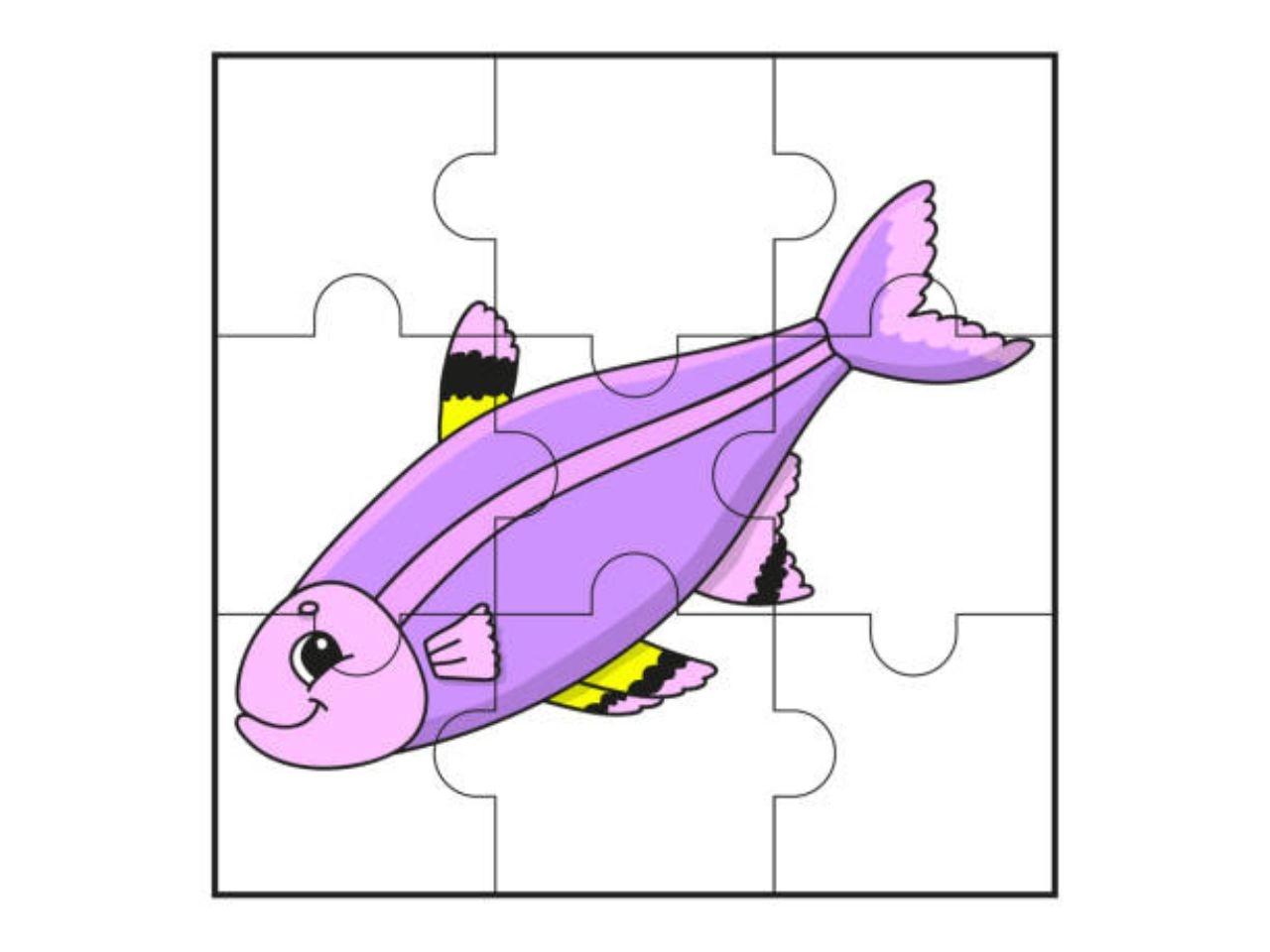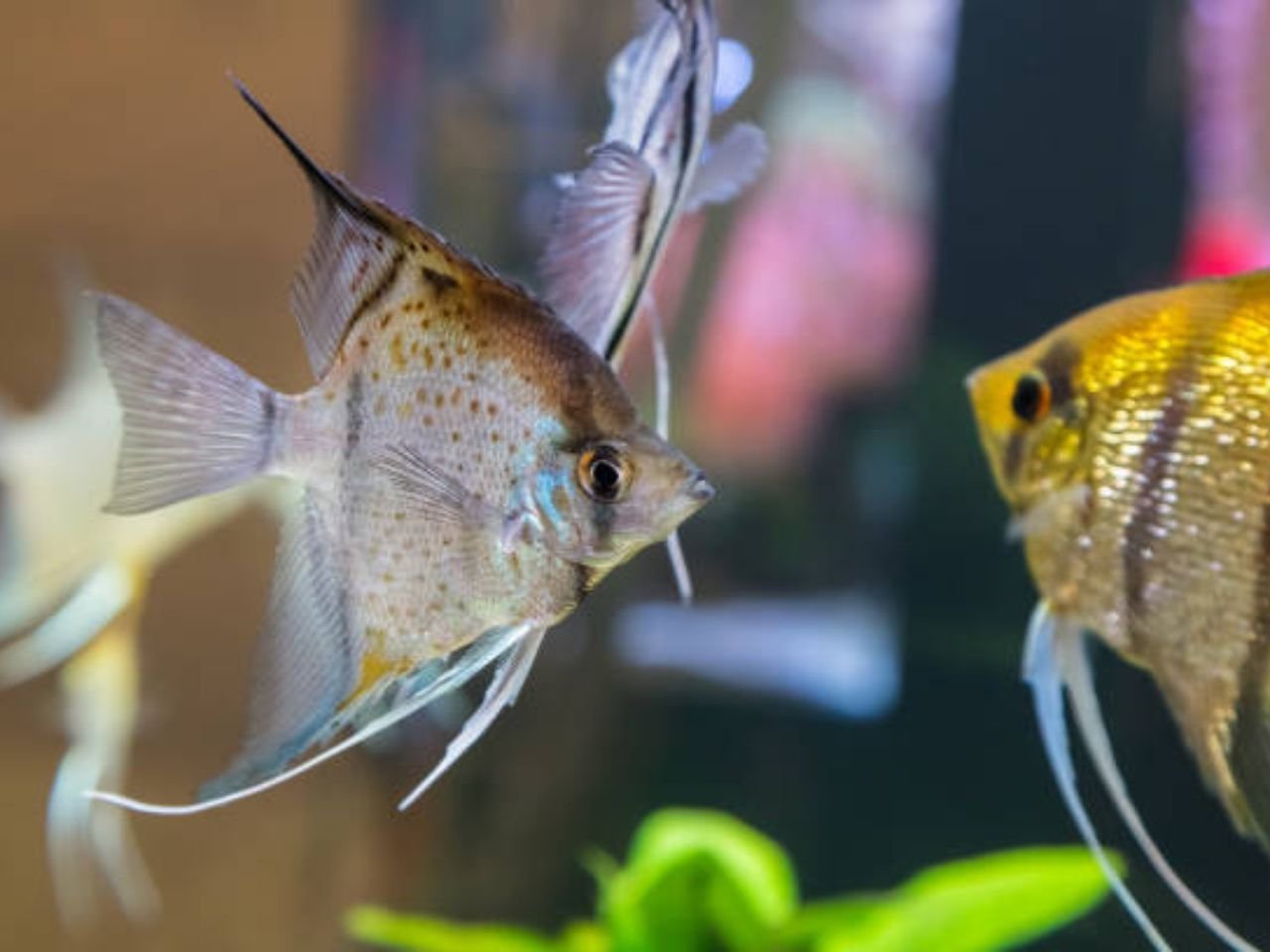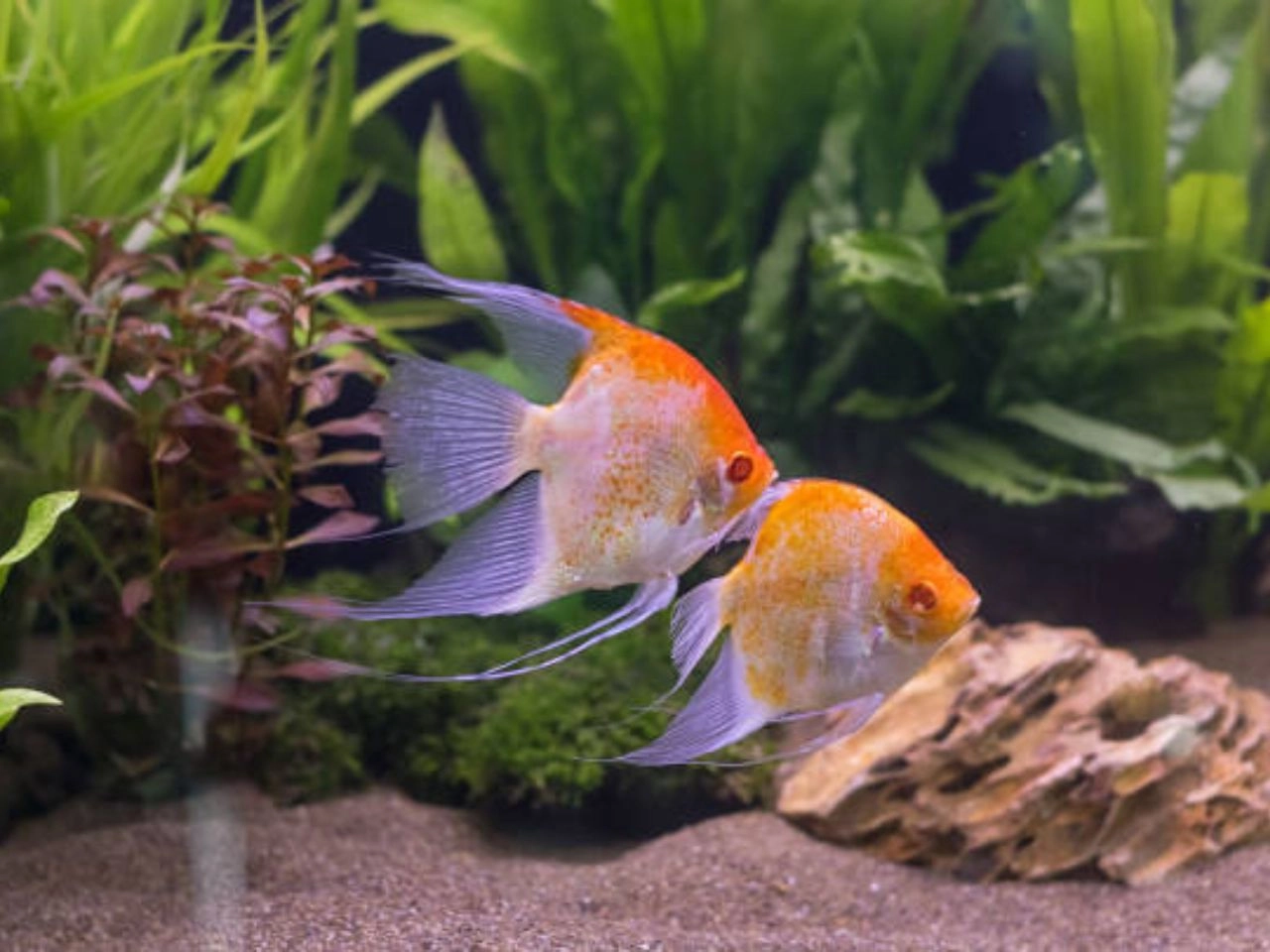Betta With Neon Tetras Fish are popular aquarium choices, but they have different care requirements. They can coexist if managed carefully.
Neon Tetras and Betta Fish both offer vibrant colors and lively behavior, making them attractive for aquariums. Neon Tetras are small, schooling fish known for their striking blue and red hues. Betta Fish, also known as Siamese fighting fish, display a wide range of colors and have flowing fins.
Although they can live together, it’s important to monitor their interactions closely. Betta Fish can be territorial, and Neon Tetras prefer swimming in groups. Providing ample space, hiding spots, and proper water conditions can enhance their coexistence. This balance ensures a healthy and visually appealing aquarium environment.
Betta With Neon Tetras
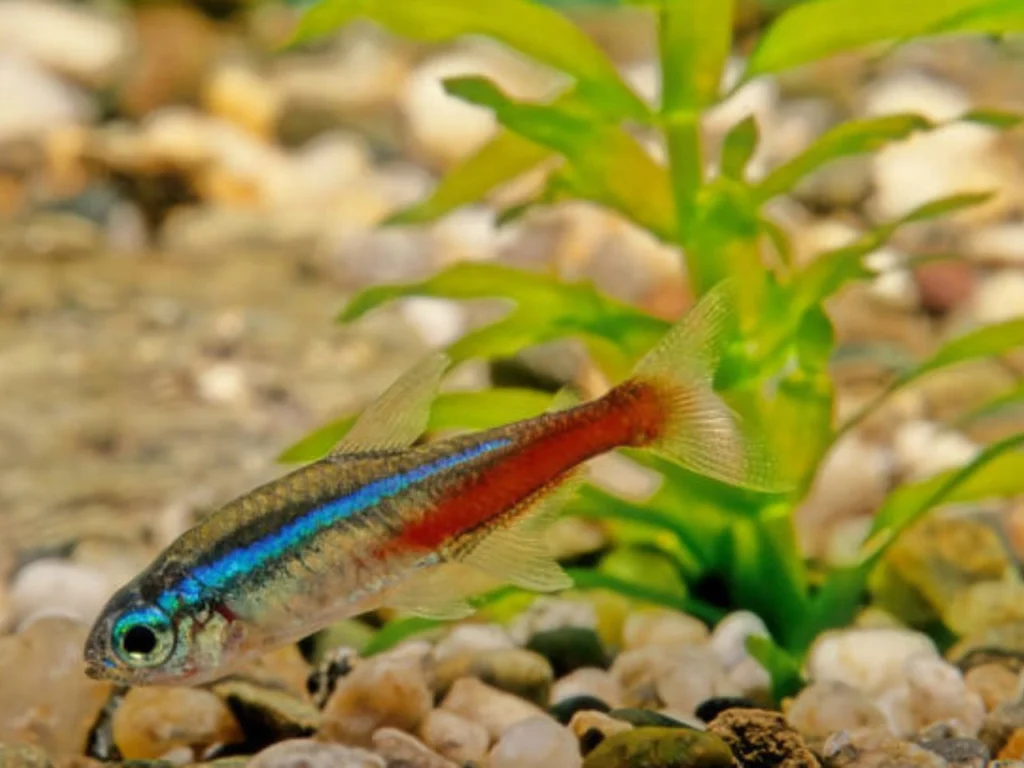
The world of aquariums is vast and captivating. Among the most popular choices are Neon Tetra and Betta Fish. These two species add vibrant colors and dynamic activity to any tank.
Neon Tetras are small, energetic, and known for their striking blue and red stripes. Betta Fish, on the other hand, are famous for their bright colors and flowing fins. Both species are beautiful, but they have different care requirements and temperaments.
Popular Aquarium Choices
| Feature | Neon Tetra | Betta Fish |
|---|---|---|
| Size | Up to 1.5 inches | Up to 3 inches |
| Water Temperature | 70-81°F | 75-80°F |
| Tank Size | 10 gallons or more | 5 gallons or more |
| Diet | Omnivore | Carnivore |
Myth Vs. Reality: Can They Coexist?
Many aquarium enthusiasts wonder if Neon Tetras and Betta Fish can live together. The reality is a bit complicated.
- Neon Tetras are peaceful and prefer to stay in schools.
- Betta Fish are territorial and may become aggressive.
While some aquarists have successfully kept them together, it is not always recommended. Betta Fish might nip at the smaller Neon Tetras, causing stress and injury.
If you choose to house them together, ensure a large tank with plenty of hiding spots. Monitor their behavior closely to ensure a peaceful coexistence.
Natural Habitats And Behaviors
Understanding the natural habitats and behaviors of Neon Tetra and Betta Fish helps in creating a suitable environment for them. These fish have unique characteristics that make them fascinating pets.
Neon Tetra In The Wild
Neon Tetras come from the freshwater rivers of South America. They thrive in the clear waters of the Amazon basin. These waters are often shaded by dense forest canopies.
In the wild, they live in large schools. This behavior provides protection from predators. They are active swimmers and enjoy spaces with plenty of hiding spots.
Neon Tetras prefers water with a pH level between 6 and 7. They also need a temperature range of 70°F to 81°F. These conditions mimic their natural habitat.
Betta Fish: Solitude Or Social?
Betta Fish originate from the shallow waters of Southeast Asia. They are often found in rice paddies, ponds, and slow-moving streams.
Bettas are known for their aggressive nature. Male Betta Fish prefer solitude and can be territorial. They will often fight other males to protect their space.
Female Betta Fish can sometimes live together. This depends on their temperament and tank size. Betta Fish thrive in warm water, ideally between 75°F and 80°F. They also need a pH level between 6.5 and 7.5.
| Fish Type | Natural Habitat | Behavior | Optimal Conditions |
|---|---|---|---|
| Neon Tetra | Amazon Basin | Schooling, Active Swimmers | pH 6-7, Temp 70°F-81°F |
| Betta Fish | Southeast Asia | Solitary (Males), Territorial | pH 6.5-7.5, Temp 75°F-80°F |
Aquarium Setup For A Mixed Habitat
Creating a mixed habitat for Neon Tetra and Betta Fish can be a rewarding experience. These two species can live together in harmony with proper planning. This section will guide you through setting up an ideal aquarium for both fish.
Ideal Tank Size And Conditions
The tank size is crucial for a mixed habitat. A larger tank provides more space and reduces territorial disputes. A 20-gallon tank is ideal for a community of Neon Tetras and a Betta. This size allows enough room for swimming and hiding.
| Parameter | Ideal Value |
|---|---|
| Temperature | 75-80°F (24-27°C) |
| pH Level | 6.0-7.0 |
| Water Hardness | Soft to medium |
Maintain consistent water quality to keep both species healthy. Use a reliable filter and heater to regulate the tank’s environment. Regular water changes are also essential.
Creating Safe Zones And Hiding Spots
Safe zones and hiding spots are vital for the well-being of both fish. Betta fish can be territorial, so creating separate areas helps reduce stress. Use plants, rocks, and decorations to create these zones.
- Live plants: Java fern, Anubias, and Amazon sword
- Rocks and caves: Natural rocks and clay pots
- Floating plants: Duckweed and water lettuce
Arrange plants and decorations thoughtfully. Ensure there are enough hiding spots for Neon Tetras. This setup will help them feel secure and reduce aggression from the Betta.
By following these guidelines, you can create a harmonious environment. Both Neon Tetra and Betta Fish will thrive in this mixed habitat.
Water Parameters For Optimal Health
Maintaining the right water parameters is crucial for the health of Neon Tetra Betta Fish. These vibrant fish thrive in specific water conditions. Ensuring proper temperature, pH levels, water hardness, and filtration is essential for their well-being.
Temperature And Ph Levels
Neon Tetra Betta Fish need a stable water temperature. The optimal range is between 74°F and 80°F (23°C to 27°C). Sudden temperature changes can stress the fish. Using a reliable aquarium heater helps maintain a consistent temperature.
The pH level is also important. These fish prefer a slightly acidic to neutral pH. The ideal range is between 6.0 and 7.0. Regularly test the water to ensure the pH stays within this range. Adjust the pH levels using pH adjusters if necessary.
Water Hardness And Filtration
Water hardness refers to the mineral content in the water. Neon Tetra Betta Fish thrive in soft to moderately hard water. The ideal range for water hardness is between 2 to 10 dGH (degrees of General Hardness). Use a water hardness test kit to monitor these levels.
Filtration is vital to keep the water clean. A good filter removes waste and toxins. It also provides the necessary oxygenation. Ensure the filter is not too strong, as strong currents can stress the fish. A gentle sponge filter works well for these fish.
| Parameter | Ideal Range |
|---|---|
| Temperature | 74°F to 80°F (23°C to 27°C) |
| pH Level | 6.0 to 7.0 |
| Water Hardness | 2 to 10 dGH |
Dietary Needs And Feeding Tips
Understanding the dietary needs of Neon Tetra and Betta Fish is essential for their health. Both species require specific nutrients to thrive. Proper feeding ensures vibrant colors and active behavior. This section covers how to meet their dietary needs and avoid common feeding mistakes.
Balanced Diet For Both Species
Neon Tetras and Betta Fish have different dietary preferences. Neon Tetras are omnivores. They enjoy a mix of plant-based and protein-rich foods. Betta Fish, on the other hand, are carnivores. They prefer a diet high in protein.
| Food Type | Neon Tetra | Betta Fish |
|---|---|---|
| Flake Food | Yes | Occasionally |
| Pellet Food | Yes | Yes |
| Frozen Food | Yes | Yes |
| Live Food | Yes | Yes |
| Vegetables | Yes | No |
Avoiding Overfeeding And Competition
Overfeeding can lead to health issues and water quality problems. Betta Fish are known to be aggressive feeders. This can cause stress and competition during feeding time.
- Feed small amounts twice a day.
- Remove uneaten food after a few minutes.
- Use a feeding ring to keep the food in one place.
- Feed Betta Fish and Neon Tetras separately if possible.
These practices help maintain a peaceful tank environment. Consistency in feeding schedules promotes better digestion and reduces waste buildup.
Introducing Neon Tetra To Betta Fish
Introducing Neon Tetra to a Betta Fish tank can be exciting. Betta Fish are known for their vibrant colors and aggressive nature. Neon Tetras are small, peaceful, and colorful. Together, they create a visually stunning aquarium. But, proper care is needed to ensure harmony.
Acclimation Process
The acclimation process is crucial. Start by floating the bag containing the Neon Tetra in the Betta tank. This helps the fish adjust to the water temperature. Do this for about 15-20 minutes.
Next, gradually add small amounts of tank water to the bag. Repeat this every five minutes for about 30 minutes. This helps the Neon Tetra get used to the water chemistry.
Use a net to transfer the Neon Tetra to the tank. Never pour the water from the bag into the tank. This can introduce harmful substances.
Monitoring Initial Interactions
Monitor the initial interactions between the Betta and Neon Tetra closely. Watch for any signs of aggression from the Betta Fish.
If the Betta Fish chases or nips at the Neon Tetra, consider using a tank divider. This will give them time to get used to each other without harm. Observe their behavior for a few days.
Ensure there are plenty of hiding spots in the tank. Use plants, rocks, and decorations. This provides shelter for the Neon Tetra and reduces stress.
| Steps | Description |
|---|---|
| 1. Float the Bag | Float the bag with Neon Tetra in the tank for 15-20 minutes. |
| 2. Gradual Water Addition | Add small amounts of tank water to the bag every five minutes. |
| 3. Transfer Using a Net | Use a net to transfer the Neon Tetra to the tank. |
- Important: Never pour bag water into the tank.
- Monitor for signs of aggression from the Betta Fish.
- Provide hiding spots to reduce stress.
- Acclimation helps fish adjust to new water conditions.
- Monitoring interactions ensures the safety for all fish.
- Hiding spots are crucial for reducing stress and promoting harmony.
Behavioral Signs Of A Successful Pairing
Understanding the behavioral signs of a successful pairing between Neon Tetra and Betta Fish is crucial. Observing these signs helps to ensure a peaceful and thriving tank environment. Below, we explore the social dynamics and how to identify stress and aggression.
Social Dynamics In A Mixed Tank
In a mixed tank, Neon Tetras and Betta Fish can coexist peacefully. Watch for calm swimming patterns in both species. Neon Tetras usually swim in groups, while Betta Fish may patrol their territory.
Look for signs of mutual respect. Tetras should not nip at the Betta’s fins. The Betta should not chase the Tetras aggressively. A successful pairing shows both species swimming freely without fear.
Identifying Stress And Aggression
Identifying stress and aggression is vital for maintaining a healthy tank. Stressed fish may display faded colors or hide often. Aggressive behavior includes fin-nipping or constant chasing.
Monitor for physical signs of stress. Look for clamped fins or rapid breathing. These symptoms indicate a need for immediate attention. An aggressive Betta may flare its gills frequently, signaling dominance.
| Behavior | Indication |
|---|---|
| Calm Swimming | Successful Pairing |
| Faded Colors | Stress |
| Fin Nipping | Aggression |
| Free Swimming | Peaceful Coexistence |
Health And Disease Prevention
Ensuring the health of your Neon Tetra Betta fish is crucial for their longevity and happiness. Understanding common health issues and maintaining a clean environment can help prevent diseases.
Common Health Issues
Neon Tetra Betta fish can face several health challenges. Identifying these problems early can save their lives.
- Ich: This is a parasitic disease. It causes white spots on the fish’s body.
- Fin Rot: Bacterial infections cause fins to fray and rot.
- Velvet: A parasite causes a gold or rust-colored dust on the fish.
- Swim Bladder Disease: It affects the fish’s ability to swim properly.
Maintaining A Clean Environment
A clean tank is essential for preventing diseases. Follow these tips to keep your Neon Tetra Betta fish healthy:
- Regular Water Changes: Change 25% of the water weekly. This reduces toxins.
- Use a Filter: A good filter keeps the water clean. It removes waste and toxins.
- Monitor Water Parameters: Keep the pH, ammonia, and nitrate levels in check. Use testing kits.
- Remove Uneaten Food: Uneaten food decomposes and pollutes the water. Remove it quickly.
- Clean the Tank: Clean the tank walls and decorations regularly. This prevents algae buildup.
Maintaining a clean tank and being vigilant about common health issues ensures your Neon Tetra Betta fish live healthy lives.
Breeding Considerations In A Community Tank
Breeding Neon Tetra Betta Fish in a community tank involves several challenges. Ensuring the safety of both adults and fry is crucial. This section covers key points to consider.
Challenges Of Breeding In Mixed Species Tanks
Mixed species tanks present unique challenges for breeding. Different species have varying needs and behaviors. These can affect the success of breeding.
- Competition for Resources: Neon Tetras and Bettas may compete for food and space. This can stress the fish, reducing breeding success.
- Predation Risk: Other fish in the tank might eat the eggs or fry. Protecting them can be difficult.
- Water Parameters: Different species may require different water conditions. Finding a balance that suits all can be tricky.
Separating Breeding Pairs
To increase breeding success, separating breeding pairs from the community tank is advisable. This ensures a safe and controlled environment.
- Use a Breeding Tank: Set up a separate tank with optimal conditions for breeding. This includes proper temperature, pH, and hiding spots.
- Introduce the Pair: Gently introduce the breeding pair to the tank. Monitor their behavior to ensure compatibility.
- Observe and Care: Watch for signs of spawning. Once eggs are laid, remove the adults to prevent them from eating the eggs.
Creating a dedicated breeding space minimizes stress and increases the likelihood of successful spawning. Proper care and attention are essential for the health of both the breeding pair and the fry.
Troubleshooting Common Problems
Keeping Neon Tetra Betta Fish can be a delightful experience. Sometimes, problems arise that need quick solutions. This section will help you handle common issues like aggression, fin-nipping, and sickness.
Aggression And Fin Nipping
Aggression and fin-nipping are common in a mixed tank. Betta fish are known for their territorial nature. They may become aggressive towards Neon Tetras.
To minimize aggression, follow these tips:
- Provide enough space: Ensure the tank is large enough for all fish.
- Add hiding spots: Use plants and decorations to create hiding places.
- Monitor behavior: Watch your fish regularly to catch any signs of aggression early.
If aggression persists, consider separating the aggressive fish into a different tank.
Dealing With Sickness In The Tank
Sickness in the tank can affect both Neon Tetras and Betta Fish. Common symptoms include lethargy, loss of appetite, and visible spots or sores.
Follow these steps to treat sick fish:
- Isolate the sick fish: Use a quarantine tank to prevent the spread of disease.
- Check water quality: Ensure the tank water is clean and well-filtered.
- Use medication: Apply appropriate fish medication as directed.
Regularly test the water and maintain good hygiene to prevent future outbreaks.
Expert Advice And Final Thoughts
Keeping a harmonious aquarium with Neon Tetra and Betta Fish can be a rewarding experience. These beautiful fish can coexist peacefully with proper care and attention. Let’s dive into some expert advice to ensure a long-lasting, peaceful environment for these aquatic companions.
When To Separate Fish
Separation is crucial when signs of aggression appear. Watch for fin nipping, chasing, or hiding. Aggression can stress the fish, leading to health issues. A separate tank or a divider can help.
Monitor behavior closely during the initial introduction phase. If aggression persists, separate immediately to prevent injury. Use the table below for quick reference on aggression signs:
| Sign of Aggression | Action Required |
|---|---|
| Fin Nipping | Separate Fish |
| Chasing | Monitor Closely |
| Hiding | Provide More Hiding Spots |
Creating A Long-term Peaceful Environment
Creating a peaceful environment is key to the well-being of Neon Tetra and Betta Fish. Follow these tips:
- Ensure ample space in the tank to reduce territorial behavior.
- Use plants and decorations to provide hiding spots and break line-of-sight.
- Maintain optimal water conditions with regular water changes and monitoring.
Feeding both species adequately can also minimize conflicts. Ensure they have enough food and feed them at the same time. This reduces competition and stress.
Lighting should be balanced. Too much light can stress fish, while too little can affect their health. Find a balance that works for both species.
- Install a gentle filter to keep water clean without creating strong currents.
- Choose compatible tank mates to avoid adding stress.
- Regularly check water parameters to ensure a healthy environment.
Consistency is key to maintaining a peaceful aquarium. Regularly observe fish behavior and make adjustments as needed.
FAQ(Betta With Neon Tetras? Betta Fish)
Can I Put A Betta Fish With Neon Tetras?
Yes, you can keep betta fish with neon tetras. Ensure the tank is large and has hiding spots.
How Many Neon Tetras Can You Put In A 10 Gallon Tank With A Betta Fish?
You can keep up to 6 neon tetras in a 10-gallon tank with a betta fish. Ensure plenty of hiding spots.
Is Tetra Water Safe For Bettas?
Yes, Tetra water is safe for bettas. It conditions tap water, making it suitable for betta fish. Always follow the instructions.
How Many Neon Tetras Are In A 5 Gallon Tank?
You can keep up to 5 neon tetras in a 5-gallon tank. Ensure proper filtration and regular water changes.
Neon Tetra and Betta Fish can coexist with proper care. Ensure their environment suits both species. Monitor their behavior closely. A well-maintained tank promotes harmony. Enjoy the beauty of these vibrant fish. Happy fish-keeping!
